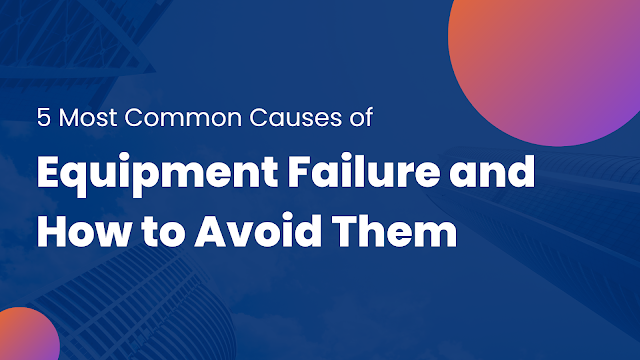The 5 Most Common Causes of Equipment Failure and How to Avoid Them
Identifying the top five common causes of equipment failure is crucial for implementing effective preventive measures. By addressing these causes proactively, organizations can minimize downtime, reduce maintenance costs, and optimize equipment performance.
Here are five common causes of equipment failure and preventive measures to avoid them:
1. Lack of Proper Maintenance: Cause: Inadequate or improper maintenance practices can lead to equipment failure over time. Neglecting routine inspections, lubrication, calibration, and component replacements can result in degraded performance and eventual breakdown.
Preventive Measures:
• Implement a comprehensive maintenance program that includes regular inspections, scheduled lubrication, and calibration.
• Create and follow maintenance checklists to ensure all necessary tasks are performed.
• Establish a robust preventive maintenance schedule based on manufacturer recommendations and equipment usage.
2. Wear and Tear: Cause: Continuous operation and usage can lead to wear and tear of components, resulting in equipment failure. Friction, corrosion, fatigue, and erosion contribute to the deterioration of critical parts.
Preventive Measures:
• Monitor equipment condition regularly through visual inspections and condition monitoring techniques.
• Implement lubrication programs to minimize friction and wear.
• Use corrosion-resistant materials and protective coatings.
• Schedule timely component replacements based on usage and manufacturer guidelines.
3. Improper Operation: Cause: Improper equipment operation, including exceeding load capacities, improper start-up or shutdown procedures, or misuse, can lead to stress, overheating, and premature failure.
Preventive Measures:
• Train operators thoroughly on equipment operation, including load limits, start-up and shutdown procedures, and safety precautions.
• Display clear instructions and guidelines near the equipment for quick reference.
• Implement automated systems or safety interlocks to prevent misuse or exceeding load capacities.
4. Environmental Factors: Cause: Harsh environmental conditions, such as extreme temperatures, humidity, dust, or corrosive substances, can significantly impact equipment performance and lifespan.
Preventive Measures:
• Conduct regular environmental assessments to identify potential risks and hazards.
• Implement proper ventilation, temperature control, and humidity management systems.
• Provide protective covers or enclosures to shield equipment from dust, moisture, or corrosive elements.
• Use appropriate coatings, sealants, or protective materials to mitigate environmental impact.
5. Ageing and Obsolescence: Cause: As equipment ages, its performance may decline, and critical components may become outdated or unavailable. Obsolescence can lead to a higher risk of failure and difficulties in finding replacement parts.
Preventive Measures:
• Implement a proactive asset management strategy that includes tracking equipment age and planning for timely replacements or upgrades.
• Conduct regular equipment evaluations to identify signs of aging or potential obsolescence.
• Establish relationships with suppliers or manufacturers to ensure the availability of replacement parts or suitable alternatives.
• Stay informed about industry advancements and technologies to anticipate and mitigate obsolescence risks.
By addressing these common causes of equipment failure through proactive measures, organizations can enhance equipment reliability, extend lifespan, and optimize overall operational efficiency. Regular maintenance, proper operation, environmental considerations, and asset management are crucial in preventing failures and maximizing equipment performance.
In conclusion, understanding the common causes of equipment failure is crucial for businesses to ensure uninterrupted operations and minimize costly downtime. By proactively addressing these issues, organizations can significantly extend the lifespan of their equipment and optimize overall productivity. Cryotos Equipment Maintenance Management Software is here to help you avoid equipment failures and maximize the reliability of your assets.
With our advanced CMMS software, you can implement preventive maintenance strategies that target the root causes of equipment failures. By scheduling regular inspections, conducting timely repairs, and tracking equipment history, you can identify trends, make data-driven decisions, and take proactive measures to mitigate potential risks.
Furthermore, our software's Asset Management functionality ensures proper tracking of equipment usage, maintenance history, and replacement schedules; This empowers organizations to optimize inventory management, reduce costs associated with unnecessary replacements, and ensure the availability of critical spare parts when needed.
With Cryotos CMMS Software, you can streamline communication and collaboration among maintenance teams, enabling them to share knowledge and best practices to prevent equipment failures. The mobile access feature facilitates real-time updates and notifications, allowing technicians to respond quickly to emerging issues and prevent further damage.
To support your journey in preventing equipment failures, Cryotos CMMS Software offers comprehensive customer support, including implementation assistance, training programs, and ongoing technical support. Our team of experts is dedicated to helping you leverage the full potential of our software to enhance your maintenance processes and drive business success.
Don't let equipment failures hinder your operations and drain your resources. Take proactive measures today with Cryotos CMMS Software. Contact our sales team to discover how our innovative software solutions can help you avoid the common causes of equipment failure, increase equipment reliability, and maximize your organization's efficiency.




Comments
Post a Comment